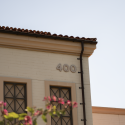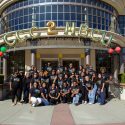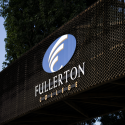The Fullerton College Pivot: Transitioning Online During Covid-19
(To mark the one-year anniversary of COVID-19, the Office of Campus Communications shares this preview of the cover article for a new publication called “Fullerton College Magazine.” The magazine will be published in late April.)
[tabs slidertype=”simple”][tab]
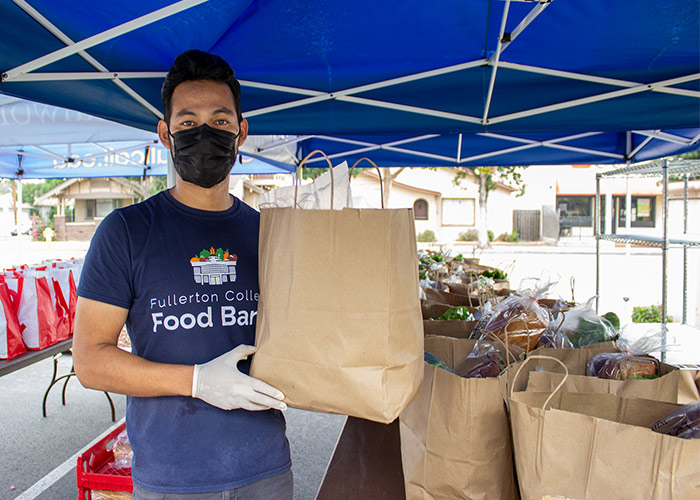
COVID-19 has required the college to help students in new ways. The Healthy Hornets Drive-Thru has provided more than 11,000 sets of groceries since April. Other new services include laptops on loan, free hot spots, telehealth for physical and mental wellbeing, and direct $500 grants to students enrolled, each semester.
[/tab][tab]
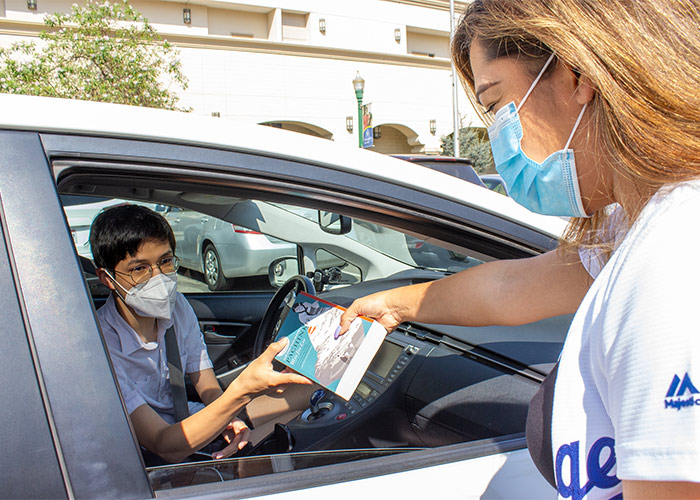
Students may access resources at the Library through a drive-thru and return books at a drop-off-box.
[/tab]
[tab]
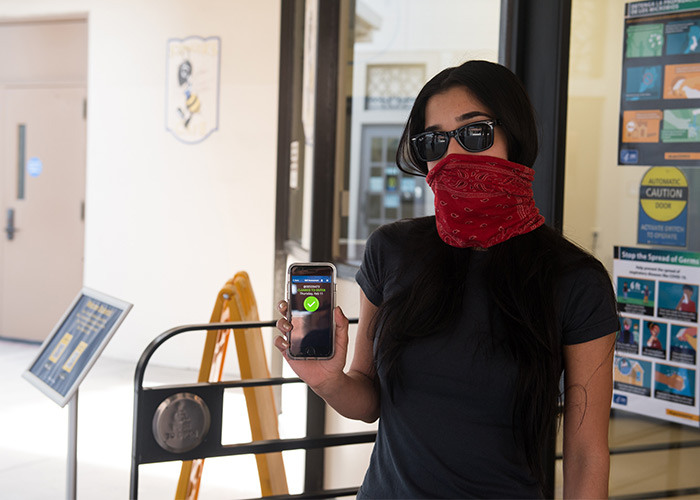
The college embraced technology in many new ways due to COVID-19, including utilizing the college’s mobile app Fullerton College Mobile to provide a user-friendly health screening process for students taking in-person classes. Students are also required to have their temperature taken if they are on campus.
[/tab]
[tab]
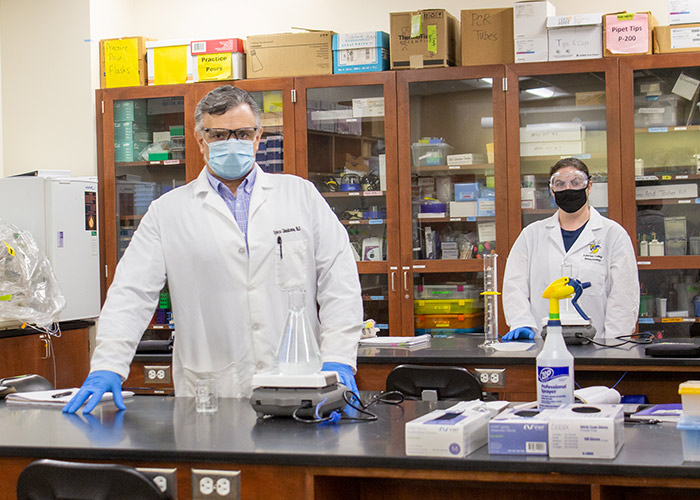
The college offered about 90 sections of hands-on lab courses during the fall and spring. Strict safety measures were in place to provide proper social distancing and sanitation. Masks are required as well.
[/tab]
[tab]
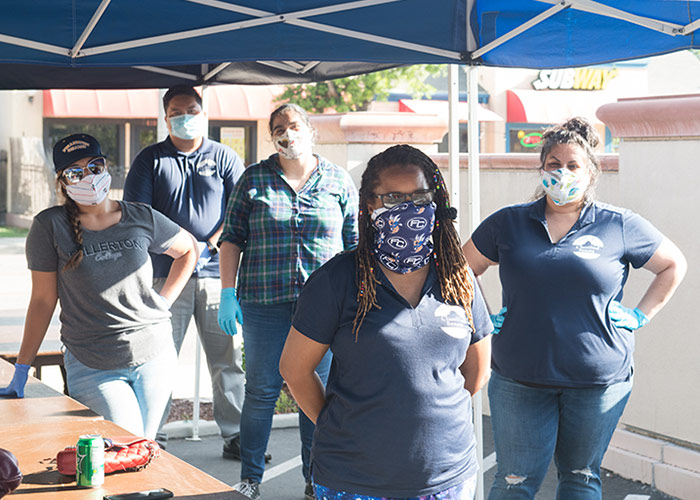
Classified professionals have provided instrumental support to the college in many ways, often as onsite essential workers.
[/tab]
[/tabs]
By Melissa Serrato
What began as a normal month in March 2020 with students preparing for mid-term exams, annual planning for campus-wide events such as Commencement, and upcoming community gatherings such as Love Fullerton and the High School Theatre Festival, life as we know it abruptly shifted focus as many began to turn their attention to national and local news concerning the spread of COVID-19.
For several days leading up to March 12, 2020, discussions about COVID-19 and how Fullerton College would respond dominated meeting spaces and casual conversations between students, faculty, and staff. Campus administrators, faculty, and staff swiftly worked behind the scenes to develop a plan to transition classes and student support services online in the event the campus had to close temporarily.
No one had done this before. There wasn’t a playbook to follow, but with heart, bravery, and a commitment to equity and student support, Fullerton College did the pandemic pivot, moving 20,000 students online and shuttering the college.
“It is remarkable to look back at that time and reflect on just how fast we had to move to keep our college community safely at home and deliver all of our instruction and support services remotely,” said Dr. Greg Schulz, president of Fullerton College. “I am grateful that the college had a strong distance education framework to switch into overdrive, and our faculty and staff got it done in a matter of days.”
On March 12, students, faculty and staff received an email from Fullerton College detailing how the campus would temporarily halt in-person class instruction for three days to allow faculty a chance to attend training and become better equipped to teach online. However, the plans changed. The deadly virus caused shutdowns worldwide. March 13 would become the last day the campus was open.
“Our plan was to spend three days of in-person lab instruction teaching faculty how to use Canvas (the college’s learning management system) and how to effectively teach online in case we had to shut down like other universities,” said Distance Education Director Darnell Kemp. “At the time, only 17 percent of faculty were using Canvas and only about 280 faculty were certified to teach online.”
Fullerton College has more than 800 full-time and part-time faculty, combined. But what happened over the next 48-hours completely changed how Fullerton College would operate over the next year.
On March 13, the Distance Education office offered the first of three in-person labs to faculty who had never taught online. Only 20 faculty members had the chance to attend the training because, by Sunday evening, all NOCCCD campuses were notified of the campus’ closure.
“I still remember that Sunday night when we received an email from NOCCCD Chancellor Cheryl Marshall telling us we would not be returning to campus until further notice,” Kemp said. “Our office had to come up with some quick solutions to help faculty take a crash course in online teaching.”
Kemp said this was made possible with the help of Distance Education Division representatives who stepped up to help other faculty during those first few days and weeks of online teaching. In addition, Kemp made sure faculty had resources within Canvas and on the Distance Education website, such as videos and tutorials, to help them get comfortable with online teaching.
“Some faculty had never really used Canvas, so it was definitely a steep learning curve for some of them,” she said.
Kemp, along with Alternate Media Specialist Cory Thomas, developed two Canvas courses titled “Canvas for Instructional Continuity” and “Rapid Remote Teaching” that served as essential pieces to transitioning faculty to remote environments. Teachers quickly became students. By March 18, more than 150 faculty had taken the courses and were prepared to teach online.
Professors such as Angie Andrus, who teaches Sociology courses at Fullerton College, had taught a couple of summer classes online but had never taught some of her in-person courses completely online, which typically hosts about 90 students each.
“I honestly thought we would only be out of the classroom for a few weeks, so when I got the news that we were transitioning to fully online I was a bit overwhelmed at first,” Andrus said. With patience and time, Andrus, much like other faculty, tried their best to create a supportive learning environment within the classroom during the first few weeks of online learning.
“I tried to keep everything the way students were used to. I did not expect them to know how to use Canvas,” she said. “I had them email me their assignments and I communicated with them every day.”
The sudden shift to online learning prompted many instructors who had never once thought of teaching online to enroll and complete FC’s Online Teaching Certification. By the end of Fall 2020, close to 600 faculty were certified to teach online, Kemp said.
“We went from 280 to 600 in a matter of months,” Kemp said. “I had a three-year plan for training faculty to teach online that turned into two semesters.”
Preparing faculty to teach online wasn’t the only challenge. When classes were moved online, students also struggled to transition from in-person classes to attending classes on Zoom and using Canvas daily.
“Online learning was much harder for me because I am a visual learner,” said Patricia James who is in her third year at Fullerton College. “I loved being on campus and going to office hours to communicate with my teachers. With online, I felt less motivated.”
James was not alone. Like her, many other students expressed a lack of motivation during the first few weeks and months while transitioning to online learning. Some students were simply unsure about their online learning capabilities, while others faced much bigger concerns, such as adequate technology and other basic needs. Kemp said the Distance Education Office made sure students had access to workshops, Canvas orientations, and a variety of support and resources available within Canvas and on the Distance Education website.
Simultaneously, Fullerton College’s Student Services stepped up to identify ways to support students in a virtual environment. Many of the Student Services areas, such as Admissions and Records, Counseling, Financial Aid, Disability Support Services, and Behavioral Health Services immediately transitioned their services to remote formats with virtual meeting room appointments and enhanced online services and websites. One of the college’s main goals during this time was identifying ways to support students with their basic needs of food and technology. Through a partnership with Sodexo Food Services and Pathways of Hope, the FC Food Bank transitioned into the Healthy Hornet Drive-Thru on April 21 and has provided more than 11,000 sets of weekly groceries. Items such as diapers, personal hygiene products, and condoms are available as well.
“It has been truly amazing to witness the ways in which our teams have adjusted to unprecedented circumstances, reimagined student support, and worked collaboratively despite our physical distances,” said Vice President of Student Services Dr. Gilbert Contreras.
Support to students also came in the form of laptop loans, media equipment, and $500 grant payments for students enrolled in the spring, summer, and fall semesters made possible through funding from the Coronavirus Aid, Relief, and Economic Security (CARES) Act and the Higher Education Emergency Relief Fund (HEERF). Additionally, when Fullerton College learned the CARES Act HEERF funding excluded undocumented students from receiving support, Fullerton College repurposed state funds to provide $500 grant payments to undocumented students.
“The past 12 months have not been easy, and I’m so grateful to our campus community for pivoting our learning and student services online,” Schulz said. “This was no small feat. Mountains were moved in a matter of days to provide the technology infrastructure needed to support students. Our students rose to the occasion with patience and grace to adapt quickly. They have been incredibly resilient throughout this pandemic and we are extremely proud of them.”
The Library and Academic Support Center (ASC) also found ways to transition their services online. The ASC began offering tutoring and workshops online while the Library offered curbside pick-up and expanded its collection of online resources and databases. Additionally, affinity programs such as Honors, Umoja, Grads to Be, EOPS, Veterans, and the Promise Program intentionally created a sense of community for the students they serve online.
“Being a part of the STEM and Honors Program makes me feel connected to the school even while at home,” said Julian Villa who began his first semester at Fullerton College in fall 2020.
Gradual, Safe Return to Campus
Though Fullerton College continues to offer most classes and services online, planning is underway to transition the college gradually and safely back to campus. In fall 2020, Fullerton College began offering about 90 sections of in-person courses in Natural Sciences, Career Technical Education, and Fine Arts. This spring, the campus continues to offer those courses and will welcome spring athletes back for in-person training, as well as open the first socially distanced study space on campus.
“A full return to our pre-pandemic normal will not be like flipping a light switch,” Schulz said. “We are taking small, but important steps based on science and guidance from the CDC and local and state agencies, to safely re-introduce in-person services and learning. Our Safe Return to Campus Task Force and its three workgroups are reviewing plans and developing recommendations that will help inform our safe return to campus, in coordination with our district and sister campuses.”
“Our community came together under unimaginable circumstances this past year, and it will be that community based on values of equity, inclusion, and radically student-centeredness that will guide us back,” President Schulz added.



